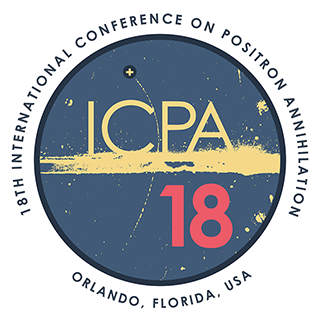
Group picture of the attendants of the 18th International Conference on Positron Annihilation. September 19, 2018. Sheraton Lake Buena Vista Resort, Orlando, USA. Download original.

Another group picture taken earlier same day. Download original.
The goal of the conference is to provide a platform for positron researchers from all over the world to present their latest research results, communicate new ideas with colleagues face to face, and to find partners for future collaboration. The conference proceedings will be published in a peer review journal, and the official language of the conference will be English.
Positron School
Positron school will be held on August 19 from 8AM to 6PM prior to our first conference gathering that evening. Since we start early it is reasonable to arrive to Orlando a day in advance on August 18.
School fee is $75. Payment workflow will be posted here soon.
The goal of the school is to present the foundation of important positron technologies as well as to introduce the basics of positron annihilation to scientists from interdisciplinary areas and students. The school will be taught by the top scientists in positron topic and directed towards both experts and beginners.
Download ICPA-18 Positron School schedule here (revision Aug 3).
- Alex Weiss. Positron surface science (link coming soon).
- Cliff Surko. Positron traps and trap-based beams - new tools for positron science. View PDF.
- Christoph Hugenschmidt. Low-energy positron beams: state of the art and current new developments. View PDF.
- Larry Burggraf. Positron chemistry. View PDF.
- Jakub Cizek. Defects in solids. View PDF.
- Morten Eldrup. On the analysis of positron lifetime spectra with emphasis on the PALSfit3 program. View PDF.
- Serge Stepanov. Positrons and positroniums in liquidsView PDF.
Conference Schedule
Positron school program and ICPA-18 conference tentative schedule (revision Aug 14) is available for download in PDF format here.
Conference Topics
- Positron and positronium physics
- Positron and positronium chemistry
- Positron and positronium interaction with atoms and molecules
- Theoretical studies of positron states
- Theoretical aspects of positron and prositronium and related physics
- Recent development in antimatter
- Polarized positrons
- High energy positrons
- Nanomaterials
- Positron applications in life sciences
- Positron and nuclear technology
- Polymers and porous materials
- Metals and alloys
- Semiconductors and nonmetallic materials
- Surface and interface
- PET and related medical applications
- New progress in experimental techniques
- Gamma induced positron spectroscopy
- Complimentary techniques to positron annihilation
- Physics related to Positron Annihilation Spectroscopy
- Radiation damage
- Positron annihilation in solutions
Presntation Guidelines
Oral presentations
- Plenary presentations are scheduled for 35 minutes. Presentations are 30 minutes with 5 minutes for questions.
- Invited presentations are scheduled for 25 minutes. Presentations are 20 minutes with 5 minutes for questions.
- Contributed presentations are scheduled for 15 minutes. Presentations are 12 minutes with 3 minutes for questions.
- Standard audiovisual equipment available includes a laptop computer with Microsoft Operating System, a LCD projector, a screen, pointer and a lapel microphone.
- Speakers should bring their presentations on a USB drive and load their presentation on the session computer at the break preceding their presentation time. (Before the start of the session or during the coffee break.) Powerpoint screen size is 4:3
Poster presentations
- Poster boards are aligned in a horizontal format. Space allocated for each poster will be 4’ wide by 4’ high. For optimal viewing we recommend posters to be 3’ height by 3.5’ wide in size.
- Push pins for posting will be available on-site.
- The following information may assist you in preparing an informative and professional poster display:
- Print TITLE and AUTHORS in extra-large characters across the top of your display.
- Display your material in large print so it may be read from a distance. It is important to use text and graphics larger and bolder than those of your manuscript! Be clear and succinct.
- Each board will be 4’ high by 4’ wide. Your optimal viewing area is 3’ x 3.5’. Boards will accept push pins which will be available.
- Each presentation will be assigned a board and will be labeled with the number of the paper (e.g. PS01) and the presenting author’s name.
Important dates
2017
2018
Conference Proceedings
ICPA-18 Proceedings will be published by American Institute of Physics (AIP) through AIP Conference Proceedings. All the submitted manuscripts to ICPA-18 meeting will be peer reviewed and published as AIP Proceedings. It will be open access to increase the visibility and spread of the proceedings. The open access publication charge is included in the registration fee. In addition, there will be a published hard copy of the proceedings upon request for little extra charge.
Please download the Microsoft Word or LaTeX templates with guidelines and instructions below.
The purpose is to have high quality publications and good reference that covers and documents the recent advances and interesting results in PAS fields. The due date for manuscript submission is August 19, 2018.
Manuscript length guideline: 4 pages for contributed abstracts, 5 pages for invited talks, 8 pages for
Registration Fees
| Participant | Early Registration |
After June 1, 2018 |
|---|---|---|
| Regular | $700 | $750 |
| Student | $350 | $400 |
| Accompany | $300 | $350 |
Correspondence
Dr. Farida Selim
Department of Physics and Astronomy
Bowling Green State University
Bowling Green, OH, USA, 43402
Updated: 12/02/2018 08:10PM

